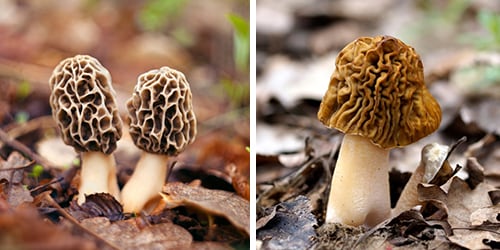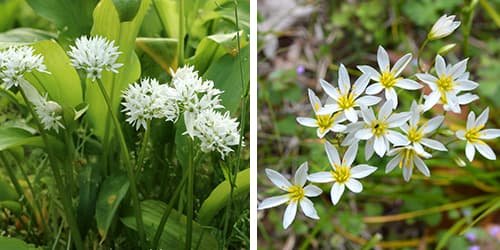
10 Medicinal Plants People Confuse With Their Poisonous Look-Alikes
In recent years, outdoor enthusiasts have become more interested in foraging local plants for food and medical purposes. Although this is a sustainable practice that should be encouraged, it also requires caution: many edible plants have poisonous doppelganger that can cause nausea, vomiting, diarrhea, and even death. In this article, we review 10 medicinal plants that people often confuse with their poisonous look-alikes and how you can spot the differences to stay safe.
Anyone who’s watched the Hunger Games movies will remember the scene where one of the tributes mistook a poisonous berry called nightlock for edible fruit and died after eating it. It’s a case of art imitating life: history is full of examples of people eating a toxic version of a consumable plant and becoming ill or dying as a result.
Black Nightshade vs. Deadly Nightshade
Once fully ripe, you can enjoy black nightshade (Solanum nigrum) berries in stews, desserts, and even raw, thereby benefiting from its immunity-boosting properties. The key is to be cautious: the berries can be toxic before they ripen and some species have produced unpleasant effects, so you need to be familiar with the type of black nightshade in your area.
⇒ Here’s The Easiest Way To Tell Apart Edible Plants and Their Poisonous Lookalikes
The plant has a dangerous imitator called deadly nightshade (Atropa belladonna). Unlike black nightshade, its fruit is glossy and borne singly instead of in clusters. The berries also have green calyces that extend collar-like past the fruit itself. The tubular bell-shaped flowers of deadly nightshade range in color from purple to lilac, unlike.black nightshade, which has tiny white flowers that are hard to spot.
Currant Tomatoes vs. Bittersweet Nightshade
The currant tomato (Solanum pimpinellifolium) is a plant that originated in South America and still grows wild throughout the Americas. In addition, it’s the ancestor of all cultivated tomatoes and has a mild, slightly sweet taste.The red currant tomato is an exceptional source of lycopene, a naturally occurring pigment and antioxidant that can prevent, fight and repair cell damage.
The currant tomato is edible, but its look alike, bittersweet nightshade (Solanum dulcamara) is highly toxic. While both plants have a woodlike climbing vine and produce flowers with five pointy petals, tomatoes have yellow flowers while those on bittersweet nightshade are deep violet.
Dandelion vs. Cat’s Ear
Dandelion (Taraxacum officinale) leaves and flowers have long been consumed as food and used as a natural diuretic. While cat’s ear (Hypochaeris radicata) is a long-standing herbal remedy for kidney issues, gallbladder problems, and rheumatism, watch out if you keep horses, as the plant can be toxic to them.
Related: Foraging Calendar: What To Forage In September
To tell them apart, take a close look at the stems. The stems of dandelion flowers are unforked and hollow, while the leaves are jagged and hairless. In contrast to dandelions, cat’s ear plants have forked stems and leaves with hairy lobes.
Sweet Almonds vs. Bitter Almonds
All almonds (Prunus dulcis) contain a certain degree of cyanide. Sweet almonds, which are those cultivated and sold for human consumption, only have trace amounts, making them a safe source of natural calcium. Bitter almonds, which are wider and shorter, contain 42 times as much cyanide.
Children can be fatally poisoned by eating just five to ten bitter almonds. Even a few nuts can cause dizziness, weakness, difficulty breathing, and other symptoms in adults. Bitter almonds are also typically grown on trees with pink blossoms, while white-blossomed trees tend to grow the sweeter varieties.
Sweet Chestnuts vs. Horse Chestnuts
Sweet chestnuts (Castanea sativa) are edible sources of antioxidants and fiber. Horse chestnuts (Aesculus hippocastanum), on the other hand, are toxic and can cause digestive disorders like stomach pain, nausea, and vomiting.
To tell them apart, take a close look at the burr: on sweet chestnuts, it is brown, has long, bristly spines, and contains two or three nuts. On horse chestnuts, the burr is thick and green, and shorter spikes, and has a single larger nut. In addition, sweet chestnut trees grow in woods and orchards while their toxic cousins tend to be found in urban areas. While you cannot safely eat horse chestnuts or feed them to livestock, they have medicinal uses. Extract from the poisonous conkers contains aescin. This is used to treat hemorrhoids and chronic venous insufficiency.
True Morels vs. False Morels
Morel mushrooms (Morchella esculenta) contain antioxidants that fight free radicals leasing to diabetes and heart disease. They are prized as culinary delicacies, but you want to avoid accidentally picking any mushrooms from the ‘false morels’ group, which are often poisonous.
⇒ The Complete Map of Edible Plants: Find Out What You Have in Your Area!
As a general rule of thumb, true morels have pitted or web-like caps, while false morels have wrinkled ones. A hollow stem and a well-attached cap are also signs of a true morel. Use caution when collecting these delicacies, and confirm with a more experienced forager if you aren’t sure.
Wild Blueberries vs. Tutsan Berries
Wild blueberries (Vaccinium Angustifolium), which are found throughout North America and Europe, have been known to boost brain function and improve heart health. They also have a potentially deadly look alike -tutsan berries- that can be found in New Zealand, Australia, and North America.
Tutsan bushes produce black berries that can look like blueberries but can cause gastrointestinal problems, weakness, raised heart rate, and other symptoms, particularly in children. The best way to tell them apart is by examining the berries themselves: blueberries are a rich shade of blue while tutsan berries are nearly black when ripe.
Wild Carrot vs. Hemlock
Wild carrots (Daucus carota), also known as Queen Anne’s Lace, have long been used to treat urinary tract problems. They have a red spot in the middle, hairy stems and stalks, and a white root that smells like carrots. The blossom folds up like a nest as it ages. However, when collecting wild carrot, you need to be vigilant, as it bears a strong resemblance to poison hemlock (Conium maculatum).
In some US states, poison hemlock is common along roadsides and in open fields. There are purple blotches on its hairless hollow stalks. The plant can grow quite tall, sometimes reaching 8 feet or more. It has an open, branching inflorescence with umbrella-shaped flowers. Wild carrots, on the other hand, have one dense flower cluster on a narrow, hairy stem, usually with a single purple flower in the center, and usually grow to three feet in height.
Wild Garlic vs. False Garlic
There are hundreds of species in the Allium genus, including garlic, chives, scallions, leeks, and many others. Wild garlic in particular has been used in traditional medicine for thousands of years: the cloves have antibacterial properties for wound care and they are often used for treating high blood pressure and digestive problems. Unfortunately, wild garlic can resemble the dangerous Anticlea or Toxicoscordion species. Commonly known as false garlic, crow poison, and death camas, these plants are highly toxic to humans and livestock.
One of the best ways to tell the difference between wild and false garlic bulbs is to smell them. With the edible variety, you’ll easily detect the pungent odor associated with garlic. False garlic bulbs have no odor at all.
Wild Grapes vs. Fox Grapes
The grapevine genus (Vitis) includes around 60 species that produce safe and edible fruit rich in antioxidants. However, fox grapes (Menispermum canadense), also known as Canadian moonseed, looks so similar to wild grapes that accidental poisoning can occur.
You can recognize moonseed berries by their crescent-shaped seeds, which have toxic levels of dauricine. The plant also doesn’t have the forked tendrils found on grapevines and the moonseeds reportedly taste terrible when bitten, which is one of the first signs you should spit it out.
For those who know what to look for, the earth can yield a tremendous bounty. By playing it safe and learning the difference between medicinal plants and their poisonous look-alikes, you can enjoy access to fresh and sustainable food and healing sources.



















Great info. Will be on guard, thank you 🙂
Hi Loretta,
We are glad you appreciate this article and that it was helpful to you.
Your feedback is very important to us.
Many blessings and good health!
I have been getting these gems of knowledge for quite some time now, and I must say , a topic like this is MUCH needed and appreciated. Also the pictures of the good plant/toxic plant side by side is , in my opinion an excellent way to educate those foraging for wild plants.
Thank you. I love what you are doing & love your books.
Hi James,
Thank you so much for your kind comment!
We are happy to hear you enjoy the books and the articles!
Many blessings and good health!
Great article. The foraging books in Australia feature cat’s ear as an edible plant. Is this incorrect?
Hi Chantel,
Thank you for your comment. Cat’s Ear is indeed an edible plant, with plenty of medicinal benefits. The bland-tasting leaves are used raw in salads, stir-fried or steamed. However, it’s very poisonous to horses. Ingesting the plant causes the appearance of Australian stringhalt. It is thus important to learn to recognize it so as to prevent the risk of poisoning to grazing horses.
Many blessings and good health!
I couldn’t believe how look alike these poisonous ☠️ plants were to the good 👍🏼 ones people could be easy tricked and get poisoned 🤮 I really liked you showing us this
Hi Barbie,
Thank you for taking the time to post this! We really appreciate it.
Our team loves to know that our readers enjoy what we do.
Many blessings and good heath!
my daughter who is a foraging buff and I were just talking about some of the plants in this article. I am so glad to be able to share it with her. Thank you for sharing this information!
Hi Teresa,
Thank you for your kind words! We’re glad to hear the article contains helpful information.
Many blessings and good health!